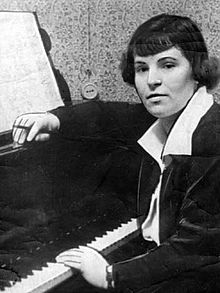 Saturday, June 17, would have been the 98th birthday of Russian composer Galina Ustvolskaya (1919-2006).
Saturday, June 17, would have been the 98th birthday of Russian composer Galina Ustvolskaya (1919-2006).
Ustvolskaya studied at the Leningrad Conservatory and was a pupil of Shostakovich who was a champion for her works, even though her style evolved to be distinctly different from her mentor’s. As a developing composer she had few opportunities to hear her works in performance. However, there has been new interest in her unique approach in recent years outside of Russia.
Known for unusual combinations of instruments, extreme dynamics, use of tone clusters, and repeated, homophonic blocks of sound, Ustvolskaya was reportedly called “the woman with the hammer” by Dutch critic Elmer Schönberger.
Alex Ross wrote about Ustvolskaya’s works in The New York Times in 1995 in response to then-renewed interest in her works. (The full piece can also be found on his blog, The Rest is Noise.) In it, Ross explore’s Ustvolskaya’s compositional style and how it changed throughout her career. His description of her writing is worth noting:
Brutality has become the hallmark of her style. But her extremities of dissonance and timbre are always set against a bracing simplicity of texture and rhythm. She is at the furthest possible remove from the Serialists, practicing complexity for complexity’s stake. Much of her work is more or less tonal, or at least modal: long, regular strings of notes in formations resembling plainchant, pinned on percussive patterns. There are also some startling stretches of untroubled lyrical repose. Most important, every passage is given a clear and vivid place in a linear narrative. Sounds become hard objects in space. As Feldman approximated certain aspects of abstract painting, Ustvolskaya has made music into sculpture.
More recently, Tom Service of The Guardian offered a guide to her music published in 2013. Service’s take on her works is also of note:
And yet Ustvolskaya’s music has, I think, a cathartic power. Just as it voices a “scream into space” – words appended to the score of the Second Symphony, “True and Eternal Bliss”, it exorcises primordial emotions of suffering and grief, and turns them into vivid, implacable creative expression. In a film made in Holland in 2005, the year before she died, Ustvolskaya spoke of the overwhelming loneliness she felt when she was writing the Second Symphony in the late 70s, and which she still feels at the end of her life. Ironically, it’s precisely because her music gives almost unbearably direct expression to this essential spiritual bleakness that it creates such an indelible but mysterious resonance in listeners today. Well, it does in me at least. Find out what you think as you experience the laser beams, black holes, and expressive radiation of Ustvolskaya’s musical world.
Learn more about Ustvolskaya – including her catalog of works, publication information, and archival information – on her official website, and read her obituary in The New York Times here.
Thanks to renewed interest, there are several good recordings of her works. Listen in to her distinct style through the Galina Ustvolskaya through our Spotify playlist:
